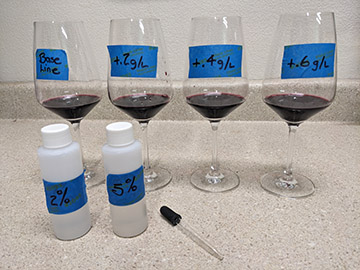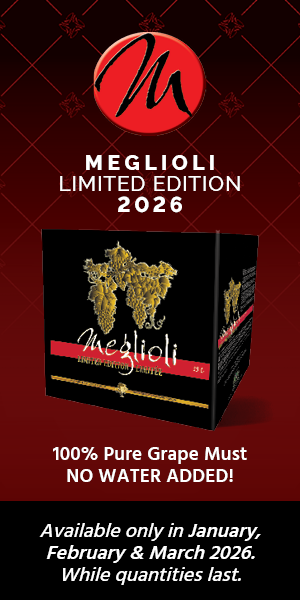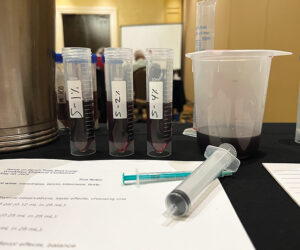Q. After malolactic fermentation (MLF) and a third racking, I measured my red wine’s pH and it was too high (4.05!). I added tartaric acid in stages until it reached 3.6, and after that performed cold stabilization. But now it tastes very tart. What is the cause? Is there a fix?
Ako Shwan
via email

A. Your wine’s sharpness after adding tartaric acid is a classic case of how pH and perceived acidity don’t always play by the same rules. You did the right thing for microbial stability by bringing the pH down from 4.05 to 3.6 (which is a much safer zone for stability), but now the wine’s balance has tipped toward an overly tart profile. Why? Because pH measures hydrogen ion concentration, while our tongues respond more to titratable acidity (TA) — the actual amount of acid in solution.
What now? You’ve got options:
1. Cold stabilization – even further?: You say you’ve already cold stabilized, which can help. But did you do it for long enough and at cold enough temperatures to really precipitate those crystals out? If you chill your wine to 32–40 °F (0–5 °C) for a few weeks, some of that excess tartaric acid will crystallize out as potassium bitartrate. Less tartaric acid = smoother taste.
2. Blending: Got a softer, rounder wine hanging around? Even a small addition of something with lower acidity could bring balance back to your batch. Sometimes blending in a variety with a little perceived richness and sweetness, like a Zinfandel or Petite Sirah, can have the appearance of lowering acidity while having it remain the same.
3. A touch of potassium bicarbonate: If the acidity is really bothering you, adding a tiny amount (think 0.25–0.5 g/L max) of potassium bicarbonate can help raise the pH slightly and soften the bite. Just be careful — it’s easy to overdo, and too much can leave a salty aftertaste.
4. Time & oak influence: If aging in a barrel or with barrel alternatives, time can work its magic. Some tannins can actually help round out acidity, toasted oak aromas can give a perception of sweetness, and slow chemical reactions will naturally smooth things over.
5. Try arabinols and mannoproteins: More on these later, but most wine supply houses like Laffort, Scott Labs, and AEB sell liquid and powdered food-safe and TTB-approved winemaking adjuncts sourced from the acacia tree (gum arabic/arabinols) and from yeast (mannoproteins). When added in small amounts (around 0.5 mL/L) they won’t reduce acidity but can reduce its perception when you taste the wine. Always follow the Wine Wizard mantra of conducting bench trials first!
Acidity is one of the great balancing acts in winemaking. It’s the backbone of a crisp Sauvignon Blanc, the driving force behind a well-structured Cabernet Sauvignon, and the reason some wines feel bright and refreshing while others seem flabby. But like salt in a favorite recipe, acidity has to be just right — too little and the wine tastes lifeless, too much and you’re puckering like you just bit into a green apple.
So, when should a winemaker step in with the acid adjustments? And when should they step back and listen to the grapes?
Reasons to Adjust Acidity:
1. pH stability & microbial protection: A high pH (above 3.8) can make a wine vulnerable to spoilage organisms and oxidation. A slight bump in tartaric acid can bring the pH down, making the wine more stable and long-lived.
2. Balance & mouthfeel: If a wine tastes flabby or dull, a touch of added acid can bring freshness and vibrancy. This is especially common in warm-climate wines, where grapes lose acidity as they ripen.
3. Malolactic fermentation (MLF) considerations: If you’re planning on MLF (which softens acidity by converting sharper malic acid into smoother lactic acid), you may need to tweak acidity before or after to ensure the final wine lands where you want it.
Reasons to Hold Off on Acid Adjustments:
1. Flavor & perception: High pH doesn’t mean it tastes too low in acid. Some wines carry acidity well, while others turn harsh with too much tartaric acid. Always taste before adjusting.
2. Cold stabilization does some work for you: If you’re aging or cold stabilizing your wine, some of the tartaric acid you add may later drop out as potassium bitartrate crystals, effectively undoing part of your adjustment.
3. Blending might be the answer: Instead of adding acid, could you blend in a more acidic wine to get the balance just right?
At the end of the day, acid is a tool in a winemaker’s kit, but like any tool, it needs to be used wisely. When in doubt, start small, taste often, and always do your bench trials first!
Q. I heard about a trick for home winemakers where bananas are used to add body and mouthfeel. So, my question now, is how many bananas would I need to add body to 5 gallons (19 L) of grape wine?
Jeff Minton
via email
A. Enhancing the body of your grape wine with bananas is a time-honored technique among home winemakers. Bananas are rich in complex polysaccharides — long-chain sugars — that, when extracted, can impart a pleasing viscosity and subtle sweetness to wines. This method is particularly beneficial for wines that may lack depth or feel “thin” on the palate.
PSA: For all of you existing or aspiring commercial winemakers out there, be aware that this unorthodox technique is for home winemakers only! If commercial winemakers like me add fruit juices or flavors to our wines, all of a sudden we’re in “formula wine” territory and it can no longer be classified as “table wine.” Home winemakers, unfettered by federal or state winemaking rules and legal definitions, you are free to roam about the cabin!
So . . . how would one even start to approach the use of bananas in home winemaking? Some winemakers first prepare what could be called “banana water.” For a 5-gallon (19-L) batch of wine, consider using 5–10 ripe bananas. Slice them and simmer in water for about 20 minutes to extract the desired compounds. It might be easier to use dried bananas (available in most grocery stores) as they won’t break down into unsightly mush during the steeping process and will be easier to strain out. For 5 gallons (19 L) — and I’m just guessing here — try a couple of handfuls simmered in 2 cups of water. After simmering, strain the mixture to remove solids, cool, and then add the resulting liquid to your primary fermentation vessel. This process not only enhances body but can also contribute to the overall mouthfeel of the finished wine.
Before you go bananas (hah!), I would ask you this: What’s your goal in using them? Is it pre-fermentation to add some polysaccharides? In that case the simple sugars will get fermented out during the winemaking process, leaving the polysaccharides for mouthfeel and not leaving you an unstable wine. However, if it’s to add body and mouthfeel to a finished wine, it’s much easier and safer to explore some of today’s cutting-edge tools to enhance body and mouthfeel. Let’s take a look at a few that can help you take your wines to the next level without introducing fermentable sugars that can cause dangerous secondary fermentations.
Mannoproteins: The Body Boosters
Derived from yeast cell walls, mannoproteins add roundness, enhance mid-palate weight, and even aid in tartrate stability.
• When to use: Typically post-fermentation, during aging, or just before bottling.
• How much: Check your supplier’s recommendations, but common doses range from 20–100 mg/L.
• How to add: Dissolve in a small amount of wine first (if it comes in powder form) then mix into your batch. Give it time to integrate and work its magic.
Gum Arabic: The Secret Softener
Derived from the acacia tree, gum arabic has been used in food and candy making for hundreds of years and helps round out tannins, reduce harshness, and create that oh-so-smooth sensation on the finish. If you’ve ever had a wine that felt velvety without being flabby, gum arabic may have played a role.
• When to use: Just before bottling for maximum impact.
• How much: Generally 10–50 mg/L.
• How to add: Pre-dissolve in a small volume of wine, mix thoroughly, and allow a settling period before bottling.
The Golden Rule: Always Bench Trial First
Always run bench trials before making any full-batch additions. Take a small sample of your wine (say, 100 mL), add a proportionate dose of your chosen additive, mix, and evaluate. Give it a little time to integrate before making your final call.
Whether you’re looking to soften astringency, build structure, or round out a thin wine, these modern winemaking tools offer home vintners a world of mouthfeel-building possibilities without having to use mushed up (and then filtered out) bananas.
Q. I’m interested in making a non-alcoholic wine at home after reading about techniques to make non-alcoholic beer in Brew Your Own magazine. Is it possible to make non-alcoholic wine at home? If not, what are the key challenges that make it more difficult compared to non-alcoholic beer? Are there any alternative techniques that could work on a small scale while preserving the wine’s character?
Lou Paradis
via email
A. With the increasing popularity of non-alcoholic (NA) wines, it’s no surprise that home winemakers are wondering if they can craft their own. The short answer is that while it’s possible to remove alcohol from wine, doing so effectively at home is extremely challenging if not downright impossible. Unlike beer, which has a lower alcohol content to begin with and a different production process, wine presents unique hurdles when it comes to alcohol removal. The primary challenge lies in removing alcohol while preserving the wine’s essential character. Alcohol contributes to a wine’s mouthfeel, structure, and aroma. Simply boiling it off, as one might with beer, isn’t ideal, since heat can destroy delicate volatile compounds, leading to a flat and unbalanced final product that doesn’t “taste like wine.” Commercial non-alcoholic wines use advanced techniques such as vacuum distillation, reverse osmosis, or spinning cone columns. These methods allow winemakers to separate alcohol from wine without excessive and complete damage to flavor and structure, but they require highly specialized and expensive equipment not to mention a litany of additives and practice to try to restore the wine back to a shadow of itself. Most if not all of this is beyond the reach of most home winemakers, which is why I think it’s more realistic to shoot for a lower-alcohol wine as a home winemaker.
Non-alcoholic beer is somewhat easier to produce because it typically starts with a lower alcohol content, usually around 4–6% ABV, whereas wine generally contains 12–15%. This means that removing alcohol from beer requires less aggressive processing. Additionally, beer’s flavor profile relies more on hops and carbonation, making it more forgiving when alcohol is removed. Wine, on the other hand, depends heavily on the balance between alcohol, acidity, tannins, and sugar. Without alcohol, wine can taste thin, overly tart, or lacking in complexity.
Brewers (and some non-alcoholic, non-wine-based beverage producers) are practically dispensing with fermentation altogether and are basing their no- and low-alcohol products on tinctures, extracts, and added aromas. Alcohol is of course a great solvent but water’s not too bad, especially when heat is involved. It’s possible to steep grains, hops, and other aromatics in order to extract a good portion of the polysaccharides, flavors, and aromas present in beer. Beer is always boiled anyway during the brewing process so these heat-extracted compounds are expected and welcomed. Because wine is not boiled, heating during the process automatically starts to take the beverage into the territory of not tasting like wine.
One way to naturally reduce alcohol content in home winemaking — without the need for complicated alcohol removal techniques — is to start with lower-sugar grapes. The sugar content of grapes, measured in Brix, determines the final alcohol level of a fermented wine. Riper grapes with higher Brix will ferment into a higher-alcohol wine, while less-ripe grapes with lower Brix produce a wine with lower alcohol. If your goal is to create a naturally lower-alcohol wine, consider harvesting grapes earlier than usual, before they reach peak ripeness. A target sugar level of 17–19 °Brix (rather than the usual 22–25 for most table wines) can result in a final alcohol content of around 9–10% ABV.
However, using lower-Brix grapes comes with trade-offs. Less-ripe grapes tend to have higher acidity, which can lead to tart or green tastes. To balance this, you may need to adjust winemaking techniques, such as using a yeast strain that enhances body and mouthfeel or incorporating blending techniques or de-acidification with potassium bicarbonate to soften the sharpness. Another option is backsweetening with a small amount of grape concentrate post-fermentation to create a more rounded, palatable wine.
Although replicating commercial alcohol-removal techniques at home isn’t realistic, a few experimental approaches might yield a wine with slightly lower alcohol content. The most straightforward method involves gently heating the wine in an attempt to evaporate the alcohol. Ideally, this should be done at a low temperature — below 140 °F (60 °C) — to minimize damage to aromatics. A double boiler or slow cooker on a low setting can help maintain gentle heat, but loss of volatile aromas and structural changes to the wine are inevitable. This method often results in a wine that tastes “cooked” or flat, so adjustments may be needed to restore balance. Personally, I’ve never attempted this (have only heard about folks trying it), so winemaker, beware!
A more practical approach might be blending finished wine with dealcoholized commercial wine or even non-fermented grape juice. This can help maintain some body and flavor while reducing overall alcohol content. However, the result will be more of a “wine-inspired” beverage rather than true non-alcoholic wine. Why not consider making your own kind of “wine cooler” or spritzer, by blending some of your lower-alcohol wine with sparkling water and adding in dashes of fruit juices or other flavors to keep the beverage interesting? If there’s residual sugar this may be tough to bottle up and keep stable but it’s certainly something you could package in a keg or mix in the moment like a wine-based cocktail.
It’s pretty much impossible to make an alcohol-free wine at home with today’s available technology without significantly compromising the wine’s character. For a more acceptable and truly non-alcoholic wine, store-bought options remain the most reliable choice. Technology is constantly evolving and with new marketplace demand, commercial NA wines are getting better and better all the time. Your best option is likely to find one you like on a shelf.







